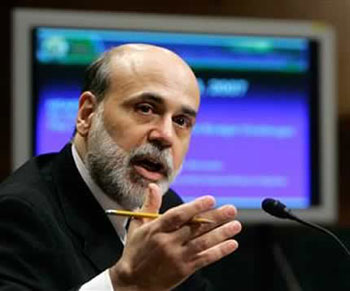 Senator David Vitter submitted one of my questions to Federal Reserve Chairman Ben Bernanke, as part of his reconfirmation hearings, and received the following reply in writing (as already published in the WSJ on-line).
Senator David Vitter submitted one of my questions to Federal Reserve Chairman Ben Bernanke, as part of his reconfirmation hearings, and received the following reply in writing (as already published in the WSJ on-line).
Q. Simon Johnson, Massachusetts Institute of Technology and blogger: Andrew Haldane, head of financial stability at the Bank of England, argues that the relationship between the banking system and the government (in the U.K. and the U.S.) creates a “doom loop” in which there are repeated boom-bust-bailout cycles that tend to get cost the taxpayer more and pose greater threat to the macro economy over time. What can be done to break this loop?
A. The “doom loop” that Andrew Haldane describes is a consequence of the problem of moral hazard in which the existence of explicit government backstops (such as deposit insurance or liquidity facilities) or of presumed government support leads firms to take on more risk or rely on less robust funding than they would otherwise. A new regulatory structure should address this problem. A. (continued) In particular, a stronger financial regulatory structure would include: a consolidated supervisory framework for all financial institutions that may pose significant risk to the financial system; consideration in this framework of the risks that an entity may pose, either through its own actions or through interactions with other firms or markets, to the broader financial system; a systemic risk oversight council to identify, and coordinate responses to, emerging risks to financial stability; and a new special resolution process that would allow the government to wind down in an orderly way a failing systemically important nonbank financial institution (the disorderly failure of which would otherwise threaten the entire financial system), while also imposing losses on the firm’s shareholders and creditors. The imposition of losses would reduce the costs to taxpayers should a failure occur.
This answer misses the central issue. Haldane’s argument (and our point) includes “time inconsistency” – i.e., you promise no bailouts today but, when faced by an awful crash, you provide a massive set of bailouts. There is nothing in Mr. Bernanke’s statements, here or elsewhere, that addresses this concern.
His hope is that current proposed changes in regulation will make a crash less likely. This is a strange assertion, given current market conditions: e.g., the Credit Default Swap (CDS) spread for Bank of America now hovers just 100 basis points above that of the US government, despite BoA having a very risky balance sheet. Creditors apparently believe they will not face losses – and the same is true for people lending to all our big banks. This is exactly the kind of thinking that produces reckless lending (and borrowing). Will Bernanke really disappoint them in our next crash?
Until markets price ”small enough to fail” risk into our biggest banks, the time inconsistency problem is alive and well – and threatening.
The Fed’s continuing refusal to confront this point directly – even as other major central banks shift their public positions (and more are moving in private) – is alarming and disconcerting. The Fed is falling far behind. This will have much broader consequences for its credibility and independence down the road.
- Bulenox: Get 45% to 91% OFF ... Use Discount Code: UNO
- Risk Our Money Not Yours | Get 50% to 90% OFF ... Use Discount Code: MMBVBKSM
Disclaimer: This page contains affiliate links. If you choose to make a purchase after clicking a link, we may receive a commission at no additional cost to you. Thank you for your support!



Leave a Reply